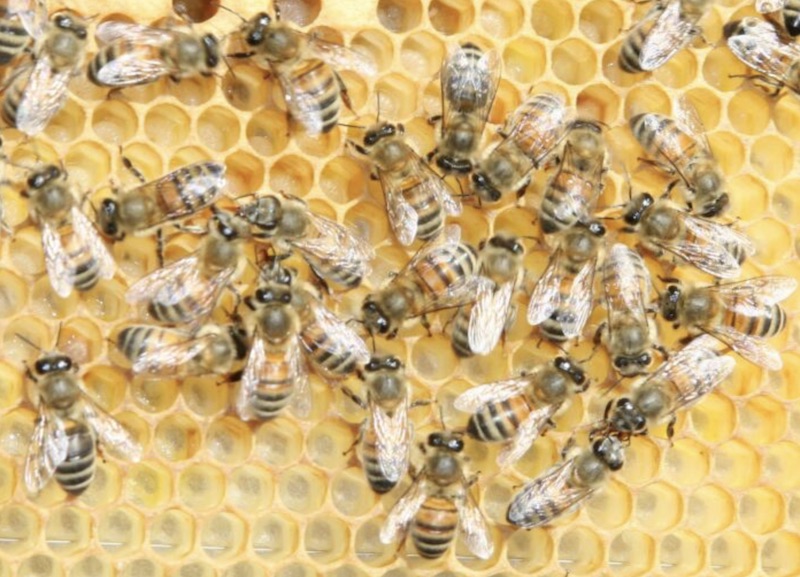The Buckfast Bee is named after Buckfast Abbey in Devon, in England, where it was first bred by famous bee breeder Brother Adam.

Brother Adam (Karl Kehrle 1898-1996) came to Buckfast Abbey from Germany at the age of 12 and began to assist the beekeeper there. In 1916, 30 of the 46 beehives at the Abbey were wiped out by Isle of Wight disease, now recognised as Acarine – a parasitic mite which moves in and occupies the windpipes of bees.
Brother Adam began to repopulate the Abbey’s hives using the existing bees which were a mixture of Italian or Italian x English dark native bees. He brought in more Italian bees and also travelled 100,000 miles across Europe and North Africa in search of desirable strains of bees to improve his ‘Buckfasts’ using an isolated mating station on Dartmoor.
What resulted was a hybrid bee which had many very good qualities. It seems likely that many of these qualities were due to the hybrid vigour of first generation crosses – and which cannot therefore be reliably passed on to subsequent generations. As a result, users of Buckfast bees must rely on breeders to requeen their bees at regular intervals otherwise their Buckfasts will simply out-cross with native stocks resulting in ‘mongrel bees’ which have, at best, mixed characteristics and are often very aggressive. Even requeening is questionable – if you have to keep doing that something is wrong. So, ask yourself – are you a beekeeper or are you just someone who hasn’t mastered the art of keeping bees?
Because of its mixed ancestry and assorted provenance the modern Buckfast bee is very variable in appearance so I’m uneasy about supplying a photo. In fact just about any bee with an orange band or two can be called a Buckfast but what on earth does that mean?
Below is a picture from Wikipedia of ‘Buckfast’ bees. They seem a bit light to me but anything is possible. However, more interesting is that two of the bees seen here are markedly darker than their sisters ( one at 12.00 and one at 8.00) which suggests that their mother, however ‘pure’ (and there is no such thing as pure Buckfast because at best Buckfast is a hybrid) has mated with a mixture of drones.

What any hybrid bee does not have in the real world is any reliability when bred from and subsequent generations will always be a mixed bag. Brother Adam was working in a different world, when Britain’s bees were thought to have been killed by Acarine and Chronic Bee Paralysis Virus (CBPV) also known as Isle of Wight Disease so it would have been much easier in those days to control the mating of queens. Such control is seldom possible here and now.
More recently it has come to light that the British native bee had not been wiped out at all but only seriously set back and efforts are now under way in parts of Britain to bring the native back. A difficult task given the number of imports of non-native and hybrid bees however, beekeepers in Cornwall have had some success and a native bee reserve has been created in the west country. Click here for more about that http://www.b4project.co.uk/
Also, and here’s interesting, the beekeeper currently running Brother Adam’s former apiary at Buckfast Abbey is breeding English native Apis mellifera mellifera again.
Because Buckfast bees reputedly build up a large colony early in the year they are thought by some to be the best ‘honey getters’. If you are one of those people, absorb and remember this sad fact – in Ireland only 2 years in any 10 can be classed as good summers, another 2 will be bloody awful summers and the remaining 6 will be the average shitty stuff. Only in the 2 good years out of 10 will a Buckfast colony have a chance of out-performing the native bee; in the other 8 you will wish you had native bees.
Also bear in mind that honey bees are the result of a 350 million-year-long breeding programme called ‘Evolution by Natural Selection’. Since the last ice age departed, they have undergone a further 12,000 years of fine-tuning during which time the native bee has survived and thrived despite every foul thing that fate and the climate has thrown at it. Do you, in your arrogance, seriously think you can better that?
Please also consider your neighbours. Tucked away in the landscape somewhere close to you could be a keeper of gentle, low-swarming native bees – the product of a breeding programmme honing the native and going back years. Your ill-considered colony of Buckfast bees will trash the work of decades. I ask you: – is that fair?
If, despite all this, you are still considering importing Buckfast bees, or buying from somebody else who imports Buckfast bees, or buying from somebody who claims to have ‘Irish Buckfast bees’ – remember this – out there Small Hive Beetle is waiting for someone just like you. Click here for more on Small Hive Beetle.
Good article on the Buckfast bee here by Roger Patterson on Dave Cushman’s website http://www.dave-cushman.net/bee/buckfast.html
Click here for more about the Native Irish Bee
Click here for updated list of Irish Native Honey Bee suppliers
Click here for more about the Italian bee
Click here for more about the Carniolan bee
Copyright © Beespoke.info, 2014. All Rights Reserved.